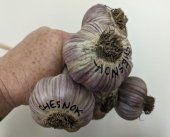


Tommy Bolin wrote:That garlic looks and sounds moldy. If that is in fact the case, then replanting is not a good idea, and your soil is contaminated for the foreseeable future.
Amy's garlic looks wonderful and she's been doing it for a minute, listen to anything she says.


Deane Adams wrote:Something to think about this winter that you may want to try next year. Selling bunched cut flowers at your market.



Denise Skidmore wrote:This was my father's method, he grew butternut annually. In addition he would heap up dirt over the stem above the wound, so the plant would be encouraged to produce more roots above the compromised nutrient route.




Todd Brewer wrote:
Apples will do well depending on variety as I have water rights and one of my property lines is the irrigation canal. USDA did a survey with me last fall and said the same. They will also subsidize the cost of high tunnel green houses up 60%? Or maybe 40% but that’s a huge help also.
My thoughts are apples, sour cherries, and Asian pears. I’m also thinking about mushrooms in one of the containers that I can sell in the farmers market or restaurants in Jackson Hole where there are deep pockets. That might be my fastest return while I wait the few years for the fruit.